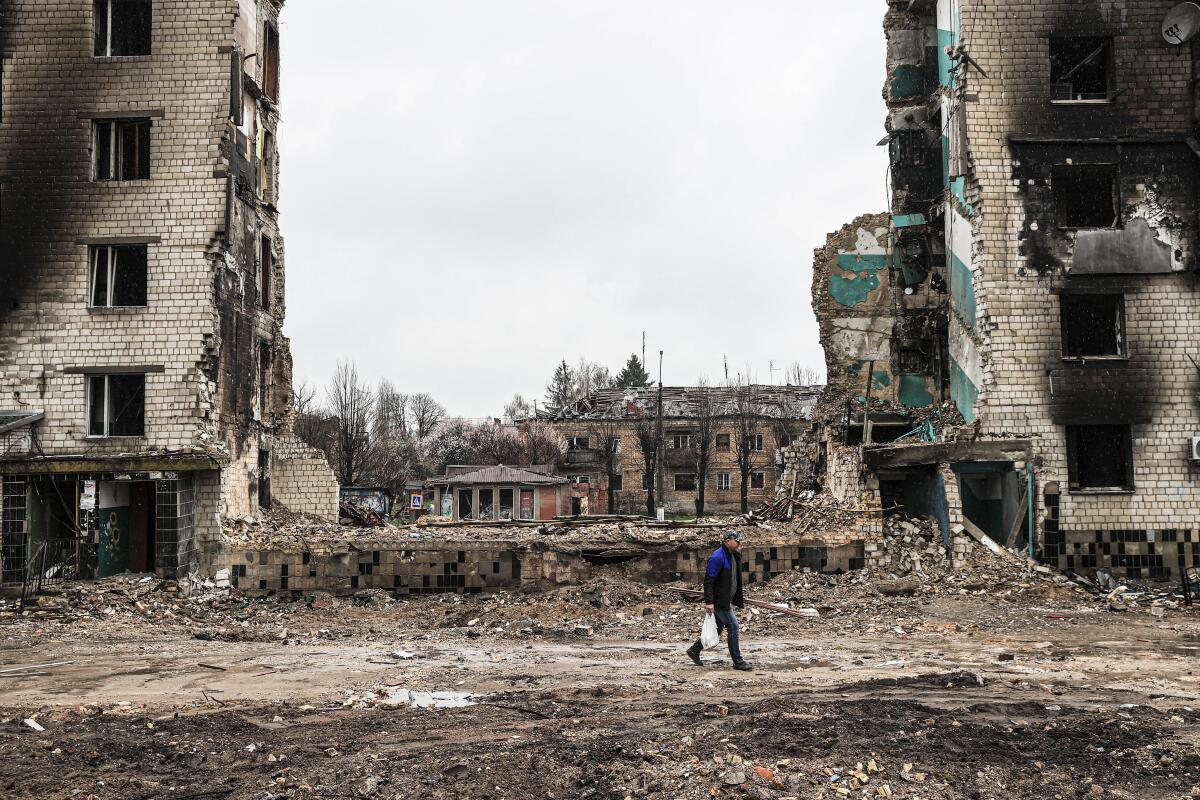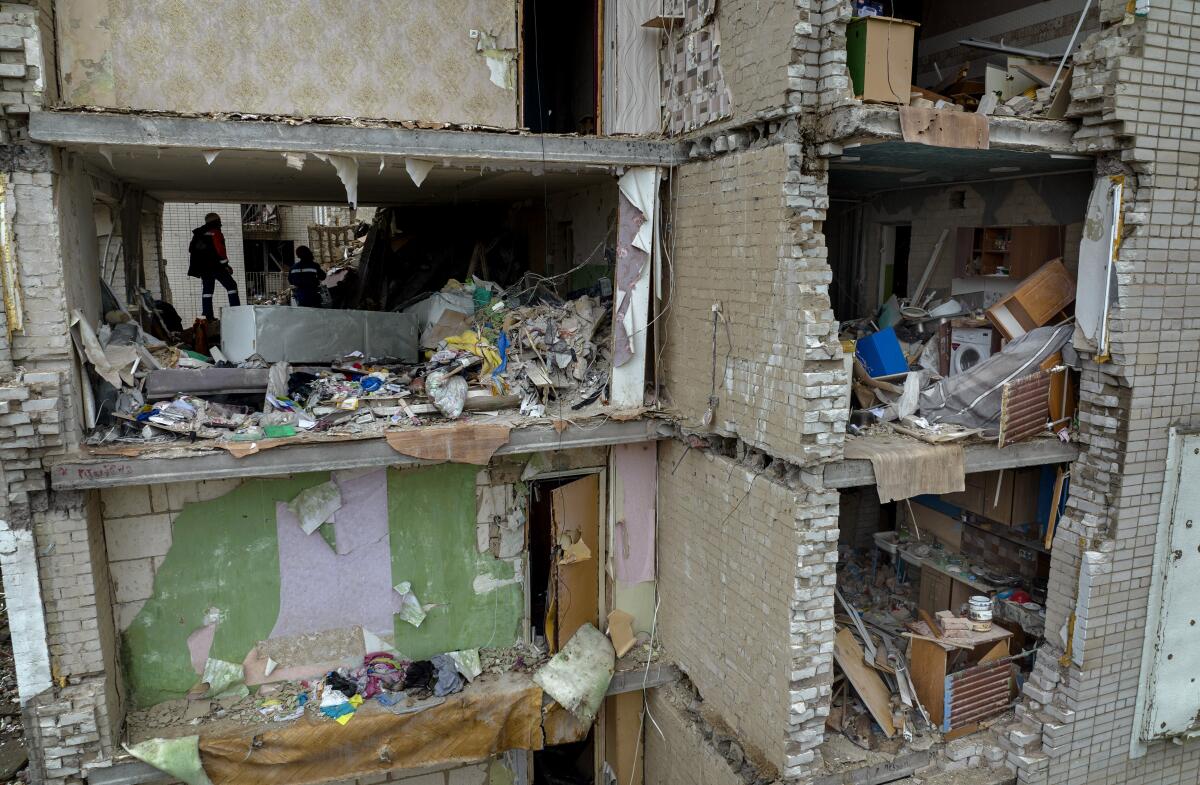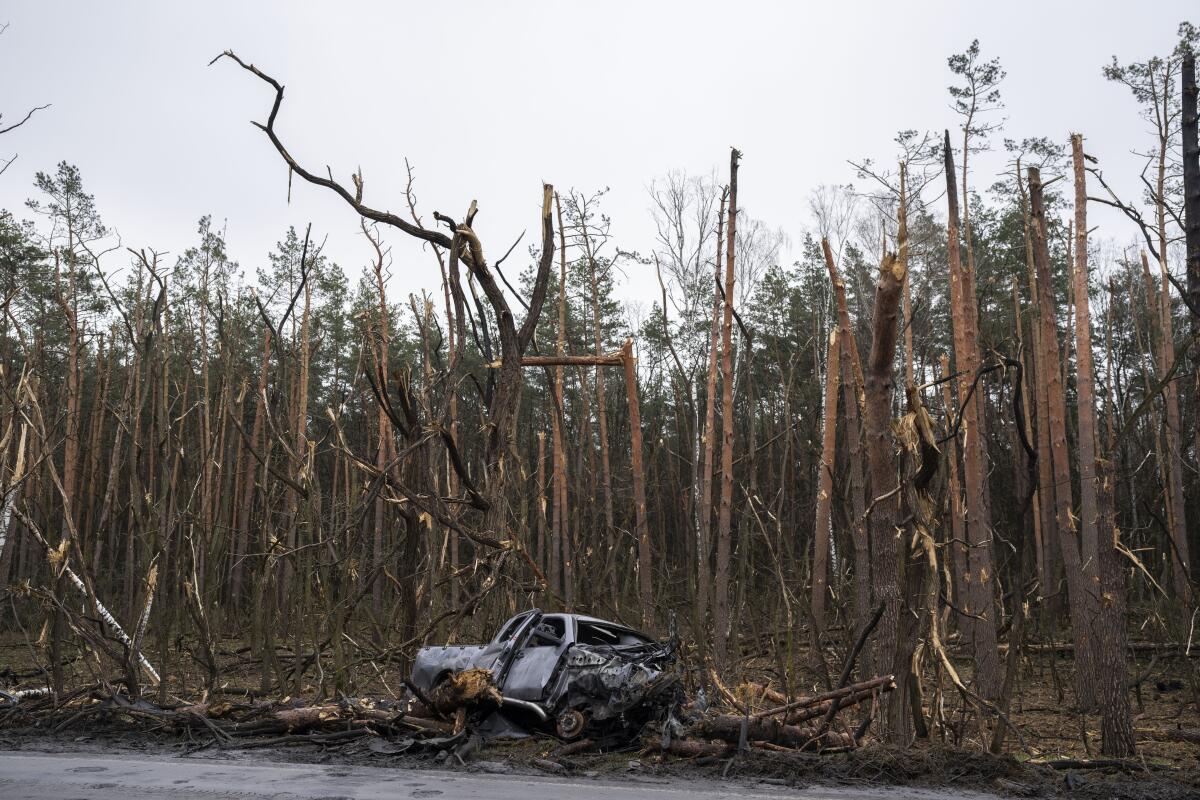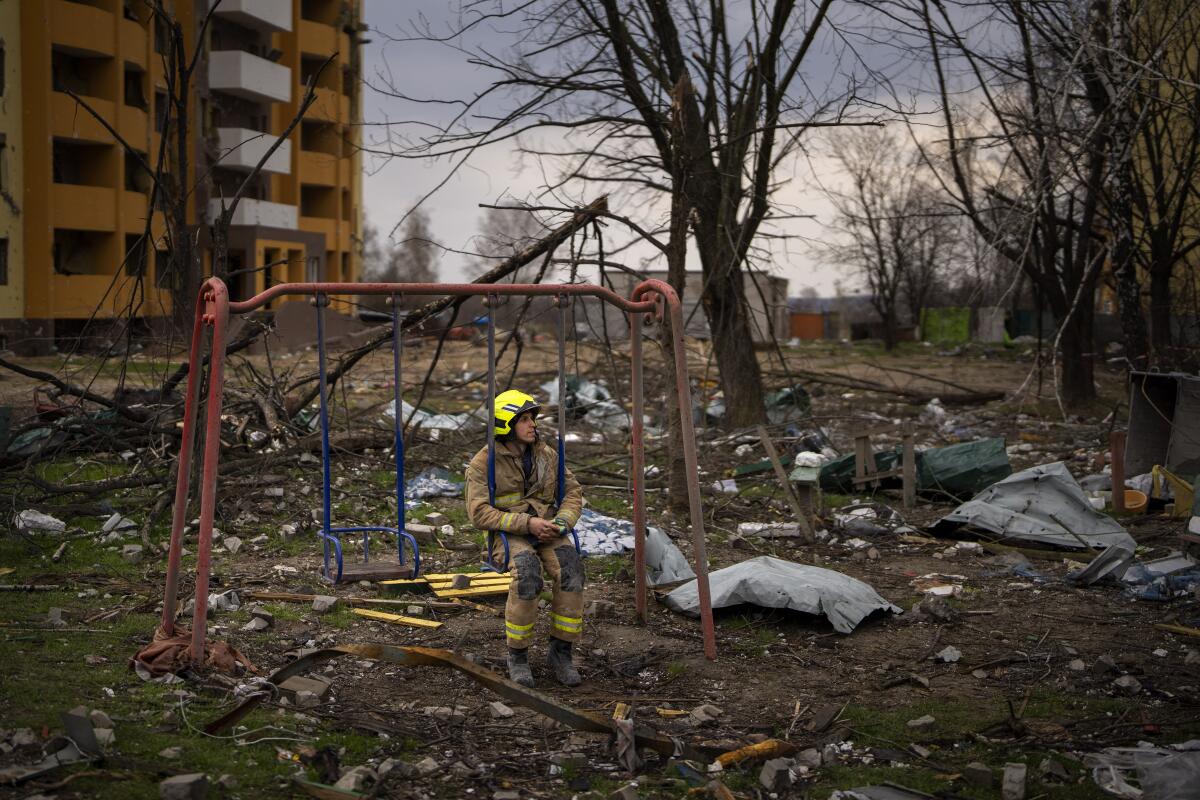Russia has advantages but faces challenges in the battle for Ukraine’s east

- Share via
SLOVYANSK, Ukraine — When Russian troops blitzed into Ukraine, what was supposed to be an easy victory quickly foundered as Ukrainian forces mounted a strong defense that — along with Russia’s many missteps — have left Moscow mired in a withering two-month war with no end in sight.
Unable to take the capital, Kyiv, Russia’s war machine has since narrowed its ambitions, focusing on an intensifying battle to win the eastern Donbas region, where fighting has been waged since Moscow’s 2014 annexation of Crimea and its backing of Ukrainian separatists.

Rather than dense urban centers, Russian and Ukrainian forces are facing off across wide tracts of mostly flat, open farmland, interspersed with smaller towns and cities with a fraction of the population of Kyiv, Kharkiv and Odesa. Such a scenario is reminiscent of the battlefields of World War II when tanks and artillery ravaged the plains of Europe.

And instead of rapier-thin thrusts to breach Ukraine’s borders, the Russian army and its separatist allies are now deployed along a contiguous front line shaped like a boomerang. That terrain begins north of Kharkiv to the city of Izyum, wrapping around the country’s eastern border and stretching along the southern coast to Kherson.
Experts say those two factors put Russia — plagued since the Feb. 24 invasion by supply, logistical, command and supply problems — in a more favorable position even as its troops have had little rest and Ukrainian forces continue to receive weapons and military technology from the U.S. and its NATO allies.
“When this war started, the Russians decided to invade from too many axes of advances, diluting the military’s capability,” said Rob Lee, a former U.S. Marine officer who is a Russia military specialist at the Philadelphia-based Foreign Policy Research Institute.

The shifting battlefield, said Lee, has changed that. Russia has a numerical advantage over the Ukrainian army when it comes to artillery, tanks and heavy units, especially when fighting in the open rather than in cities, where armor is less effective and big armies must often contend with swift-moving guerrilla offensives.
The Russians are also benefiting from maneuvering on territory controlled by Moscow-backed separatists who claimed roughly a third of the Donbas region before the wider war began. Russia won’t have to deal with the supply-line setbacks it faced in the initial phase of the invasion, when it had amassed as many as 190,000 troops along Ukraine’s borders, said John Arterbury, a European security expert at Navanti, based in Arlington, Va.
“They can equip directly from the separatist and border areas, and wouldn’t have to route them through Belarus and other areas,” he said. “They have a shorter head-to-tail logistic supply line, which would presumably allow them more cohesive advances.”
Despite assertions that the major offensive in the east has already begun, there so far have been no big tank battles. But multiple visits to different parts of the front lines, where dozens of towns have been battered and graves freshly dug, indicate the foundations for a large Russian advance against Ukrainian forces is almost in place.
Russian President Vladimir Putin — stung this month by the sinking of his nation’s flagship off the coast of Ukraine — is desperate for a military win ahead of the May 9 celebration of Russia’s victory over Nazi Germany in World War II.

In Severodonetsk, the easternmost tip of Ukrainian government control, one officer, who gave his name as Andrey, said that recent days had seen a sharp increase in Russia’s military presence — including 100 armored vehicles and special forces operatives — in Kreminna, 12 miles to the northwest and the first town to be captured by Russian forces since the new phase of the operation began.
Russia has also ramped up the use of artillery and drones, rather than launching the smaller incursions that proved its undoing on the outskirts of Kyiv, where its forces were bogged down for weeks and unable to penetrate the capital. Some analysts suggest that Russia has a Potemkin army — one that looks good, trains well, but has failed on the battlefield.
“Before, they were trying to move fast,” said Andrey. “Now they’re going slowly and preparing fortifications, something more for a long war.”
The picture is different closer to Izyum. There, said Lt. Vladimir, who works with a special reconnaissance unit and asked to be identified by only one name, Moscow’s forces have swarmed small villages with large amounts of armor as they engage in a sort of thunder run to attack the city of Lyman from two sides.
That puts them about 12 miles northeast of Slovyansk, which, along with neighboring Kramatorsk, are seen as the linchpins needed for Russia to link up with forces coming from the south, including from the besieged port city of Mariupol, in a strategy to encircle the Ukrainian army.
The lieutenant said the Russians appeared to have learned from past mistakes.
“When we try to target them with artillery with coordinates from our drones, they move very quickly into the forests and hide,” he said.
Ukraine, meanwhile, has fortified its defenses in the area, building on the already large troop presence set up in the Donbas over the nearly eight years of war with the separatists.
In recent days, convoys of heavy materiel, including howitzers, tanks, multiple-rocket launcher trucks and other armored vehicles — many of them camouflaged with branches of trees to blend in with the forests — have appeared on the streets of Kramatorsk, Slovyansk and Lyman.
Authorities have employed similar tactics to those they used in the run-up to the assault on Kyiv: blowing up bridges, introducing chokepoints on highways with antitank Czech hedgehogs and obscuring road signs to confuse the Russian invaders. One such sign outside Slovyansk had profanities spray-painted over each city name.
Meanwhile, Ukrainian forces have dug trenches in the fields by major highways, with the aim of denying Russian armor the ability to move off-road, even as the intense rains of the Ukrainian spring have turned fields into muddy pits that slow heavy vehicles.
The coming battle will put additional pressure on a Russian army, which includes mercenaries from Syria and Libya, still reeling from its losses in the first round of the invasion. Recent estimates put the losses at somewhere above 13,000 dead, double that figure of wounded, with an additional 7,000 missing.
“The force they’ve cobbled together, it’s dramatically diminished compared to what they started the war with,” said Michael Kofman, the Russian studies director at the CNA think tank in Arlington, Va.
Although the task set before them is different from the diffuse, multi-front assault they planned in the beginning, “it still doesn’t mean that all the Russian forces are well positioned to take on the fairly sizable number of Ukrainian units defending the Donbas,” he added.
And the attrition among Russian units will only increase as the offensive drags on, Arterbury said: “They’re pulling units from everywhere, and you can’t keep every unit on the front line, and ultimately the question is how long can they put up with it.”

The situation regarding Ukrainian losses is more opaque. Last week, Ukrainian President Volodymyr Zelensky said between 2,500 and 3,000 Ukrainian soldiers had been killed and roughly 10,000 wounded. Western intelligence agencies estimate the casualties are more than twice those numbers.
Yet the bigger issue is equipment losses, with Ukraine unable to replace tanks and heavy weaponry at the rate that Russia can, Arterbury said.
“Ukraine can still trade space for time,” Lee said. “No country wants to give up land, but ultimately, if they pull back if it’s too difficult, they can still do that, and still try to maintain a more defensible position.”
Whatever the outcome, Kofman said, Russia’s army will be ill-equipped to continue fighting for more territory.
“The reality is that whatever happens in the next fighting, the Russian military is likely to be exhausted afterward,” he said. “The likelihood of them going beyond the Donbas is quite low.”
More to Read
Sign up for Essential California
The most important California stories and recommendations in your inbox every morning.
You may occasionally receive promotional content from the Los Angeles Times.














